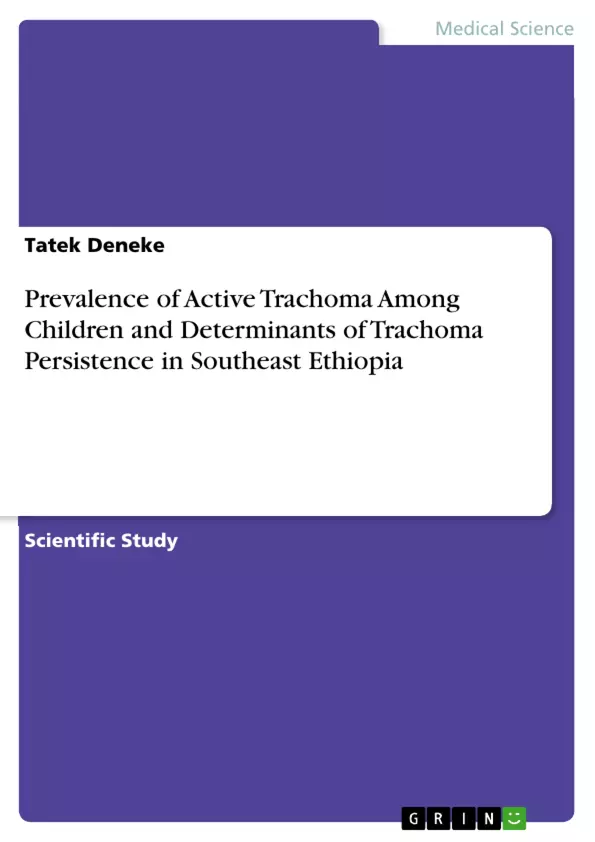This study evaluates the prevalence of active trachoma among children aged 1-9 in the Meda Wolabu District, Southeast Ethiopia, and analyzes factors contributing to its persistence despite the implementation of the SAFE strategy (Surgery, Antibiotics, Facial Cleanliness, and Environmental Improvement). Ethiopia, particularly Oromia Region, is heavily affected by trachoma, a major public health problem. This research identified key risk factors, including lack of health education, poor hygiene practices, and inadequate participation in mass drug administration (MDA) campaigns. The results underscore the need for enhanced intervention measures, particularly focused on environmental improvements and hygiene education, to meet the World Health Organization’s trachoma elimination targets.
Inhaltsverzeichnis (Table of Contents)
- ABSTRACT
- LIST OF ABBREVIATIONS
- LIST OF FIGURES
- LISTS OF TABLE
- 1. INTRODUCTION
- 1.1. Background
- 1.2. Statement of the problem
- 1.3. Significance of the study
- 2. REVIEW OF RELATED LITERATURE
- 2.1. Prevalence of Active Trachoma
- 2.2. Factors associated with the prevalence of active trachoma in Relation to SAFE
- 2.2. Conceptual framework and study
- 3 OBJECTIVES AND SCOPE OF THE PROJECT
- 3.1. General Objective
- 3.2. Specific Objectives
- 4 STUDY METHODOLOGY
- 4. 1 Study design, Study period and Study area
- 4.2. Source Population and Study Population
- 4.3 Inclusion and exclusion criteria
- 4.4 Sample Size and Sampling Technique
- 4.5.1. Sample Size Determination
- 4.5.2. Sampling technique and Sampling procedure
- 4.5.3. Sampling frame from 4 kebeles
- 4.6. Data collection tools and procedures
- 4.7. Data quality control
- 4.8Operational Definition
- 4.9. Study Variables
- 4..9.1 Dependent Variables
- 4.9. 2 Independent Variables (As related to SAFE strategy)
- 4.10. Data analysis
- 4.11. Ethical consideration
- 5 RESULTS
- 5.1 Socio demographic and households characteristics of study participants
- 5.2. Implementation of SAFE strategies in Bale zone, Meda Wolabu district, 2023
- 5.3. Prevalence of active trachoma among children aged 1-9 years in rural kebeles of Meda Wolabu district, 2023
- 5.4. Factors associated with active trachoma in rural kebeles of Meda Wolabu district
- 6 DISCUSSION
Zielsetzung und Themenschwerpunkte (Objectives and Key Themes)
This research report aims to assess the prevalence of active trachoma in children aged 1-9 years in rural kebeles of Meda Wolabu district, Oromia region, Ethiopia, and to identify factors associated with its prevalence in relation to the SAFE strategy implementation. The study employs a community-based cross-sectional design.
- Prevalence of active trachoma in children.
- Effectiveness of the SAFE strategy in reducing trachoma prevalence.
- Identification of risk factors associated with active trachoma.
- Socio-demographic and household characteristics influencing trachoma prevalence.
- Assessment of SAFE strategy implementation aspects (Surgery, Antibiotics, Face washing, Environment).
Zusammenfassung der Kapitel (Chapter Summaries)
Chapter 1: Introduction provides background information on trachoma in Ethiopia, highlighting the ongoing public health challenge despite the implementation of the SAFE strategy. It outlines the study's objectives and significance.
Chapter 2: Review of Related Literature examines existing research on trachoma prevalence and associated factors, setting the stage for the current study.
Chapter 3: Objectives and Scope of the Project details the study's general and specific objectives and scope.
Chapter 4: Study Methodology describes the study design, sampling techniques, data collection methods, and data analysis procedures used in the research.
Chapter 5: Results presents findings on socio-demographic characteristics, SAFE strategy implementation, trachoma prevalence, and associated factors. Specific prevalence rates and associated factors will be discussed in the final report.
Chapter 6: Discussion analyzes the findings in relation to existing literature and explores the implications of the results. (Note: Conclusion and Recommendations are omitted to avoid spoilers).
Schlüsselwörter (Keywords)
Prevalence of active trachoma, associated factors, SAFE strategy, Ethiopia, Meda Wolabu district, children, public health, risk factors, community-based study, intervention.
- Quote paper
- Tatek Deneke (Author), 2023, Prevalence of Active Trachoma Among Children and Determinants of Trachoma Persistence in Southeast Ethiopia, Munich, GRIN Verlag, https://www.grin.com/document/1501638



